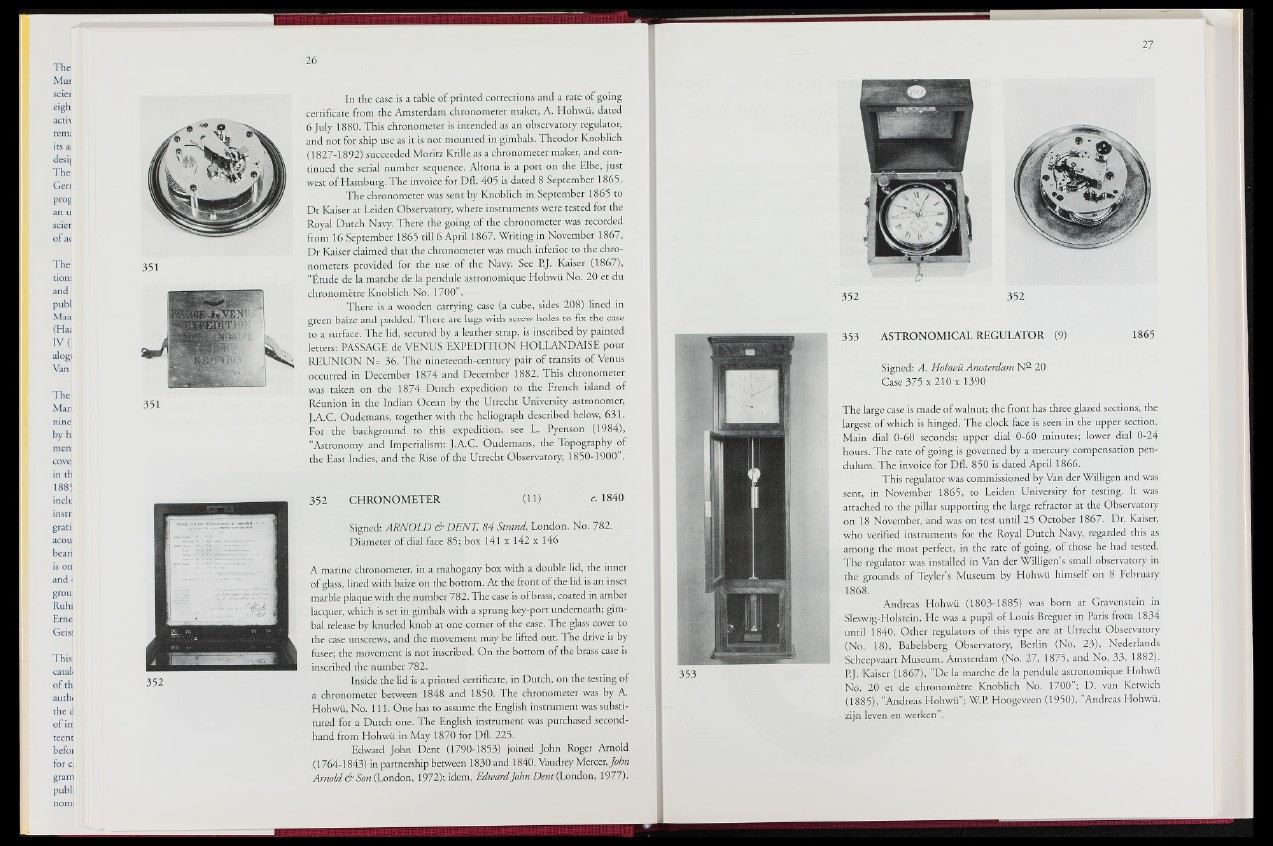
The
Mus
sciex
eigh
acti\
remi
ics ai
desi|
The
Gerì
prog
an u
scier
of a<
The
tionj
and
pubi
Maa
(Hai
IV (
alogi
Van
The
Man
nine
by h
men
cove:
in th
188f
inclij
instr
grati
acou
beari
is on
and i
grou
Ruhi
Erne
Geisj
This
cataL
of th
authi
thè d
of in
teeni
befoi
for q
gram
pubi)
nomi
In the case is a table of printed corrections and a rate of going
certificate from the Amsterdam chronometer maker, A. Hohwii, dated
6 July 1880. This chronometer is intended as an observatory regulator,
and not for ship use as it is not mounted in gimbals. Theodor Knoblich
(1827-1892) succeeded Moritz Krille as a chronometer maker, and continued
the serial number sequence. Altona is a port on the Elbe, just
west of Hamburg. The invoice for Dfl. 405 is dated 8 September 1865.
The chronometer was sent by Knoblich in September 1865 to
Dr Kaiser at Leiden Observatory, where instruments were tested for the
Royal Dutch Navy. There the going of the chronometer was recorded
from 16 September 1865 till 6 April 1867. Writing in November 1867,
Dr Kaiser claimed that the chronometer was much inferior to the chronometers
provided for the use of the Navy. See P.J. Kaiser (1867),
"Étude de la marche de la pendule astronomique'Hohwü No. 20 et du
chronomètre Knoblich No. 1700".
There is a wooden carrying case (a cube, sides 208) lined in
green baize and padded. There are lugs with screw holes to fix the case
to a surface. The lid, secured by a leather strap, is inscribed by painted
letters: PASSAGE de VENUS EXPEDITION HOLLANDAISE pour
REUNION N= 36. The nineteenth-century pair of transits of Venus
occurred in December 1874 and December 1882. This .chronometer
was taken on the 1874 Dutch expedition to the French island of
Réunion in the Indian Ocean by the Utrecht University astronomer,;
J.A.C. Oudemans, together with the heliograph described below, 631.
For the background to this expedition, see L. Pyenson (1984);,'
"Astronomy and Imperialism: J.A.C. Oudemans, die Topography of
the East Indies, and the Rise of the Utrecht Observatory, 1850-1900".
352 CHRONOMETER (11)1 H 1840
352
Signed: ARNOLD &DENT, 84 Strand, London...No. 782.
Diameter of dial face 85; box 141 x 142 x 146
A marine chronometer, in a mahogany box with a double lid, the inner
of glass, lined with baize p i the bottom. At the front of the'-Jd is an inset
marble plaque with the number 782. The case is of brass, coated in amber
lacquer, which is set in gimbals with a sprung key-port underneath; gim-
bal release by knurled knob at one corner of the case. The glass cover to.
the case unscrews, and the movement may be lifted out. The drive is by
fusee; the movement is not inscribed. On the bottom of the brass case is
inscribed the number 782.
Inside the lid is a printed certificate, in Dutch, on the testing of
a chronometer between 1848 and 1850. The chronometer w a s^A ..
Hohwii, No. 111. One has to assume the English instrument was substituted
for a Dutch one. The English instrument was purchased secondhand
from Hohwii in May 1870 for Dfl. 225.
Edward John Dent (1790-1853) joined John Roger Arnold
(1764-1843) in partnership between 1830 and 1840. Vaudrey Mercer,> 6»
Arnold&Son (London, 1972); idem, EdwardJohn Dent (London, 1977)
352 352
353 ASTRONOMICAL REGULATOR ( # 1865
Signed: A. Hohwü Amsterdam N— 20
Case 3Ü x S b x 1390
The large case is made of walnut; the front has three glazed s||tions, the
largest of which is hinged. The dock face is seen in the upper section.
Main dial 0-60 seconds; upper dial 0-60 minutes; lower dial 0-24
hours. The rate of going is governed by a mercury compensation pendulum.
The invoice for Dfl. 850 is dated April 1866.
This regulator was commissioned by Van der Willigen and was
sent, in November 18<jj to Leiden University for « S in g . It was
attached to the pillar supporting the large refractor at the Observatory
on 18 ÿjovember, and was on tW until 25 October 18'^|| Dr. Kaiser,
who verified Instruments for the Royal Dutch Navy, regarded this as
among the most perfect, in the rate of going, of those he had tested.
The regulator was installed in Van der Willigen s small observatory in
the grounds of Teyler's Museum by Hohwii himself on 8Bebruary
1868.
Andreas Hohwü ;Çl 803-1885): was b o r n É Gravenstein in
Sleswig-1 lolsrcin. 1 le was a pupil of Louis Breguet ip Paris from 1834
until 1840. Other regulators of this type are at Utrecht Observatory
(No. 18), Babeijerg Observatory, Berlin (No." 23), Nederlands
Scheepvaart Museum, Amsterdam ||}o. 2771875, and No. 33|f|882).
RJ. Kaiser (1867jU'De la marche de la pendule astronomique Hohwü
No. 20 etfgSI chronomètre Knoblich No. . 1700";; D. van Ketwich
(1885), "Andreas Hohwü"; W.P. Hoogeveen (1950), "Andreas Hohwü,
¡fljn leven en werken".